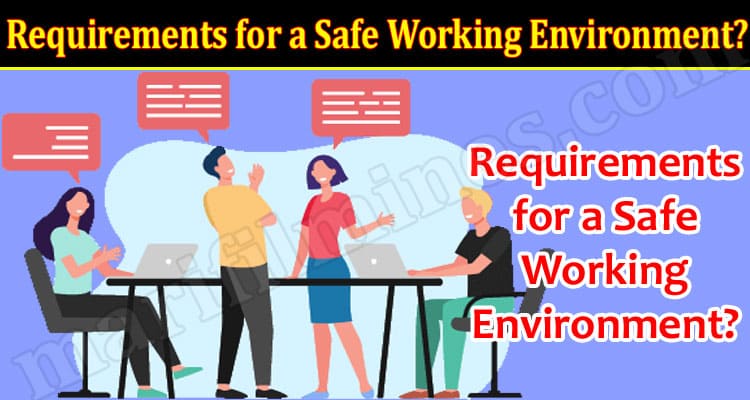Safe Working Environment: It is easy to take safety requirements and precautions for granted at a workplace. While organisations and employers are responsible for providing a safe working environment, employees have to make sure that any new issues are reported to their managers as well to ensure that safety is not compromised when working.
The responsibility still falls upon the employer, who has to abide by a number of safe working practices in order to comply with UK’s tight regulations. Chartered bodies such as Institution of Occupational Safety and Health (IOSH) offer courses through certified providers, such as this IOSH managing safely course, that can help train managerial staff in ensuring a safe environment for employees.
Employer Duties for a Safe Working Environment
Organisations have to first and foremost make sure that the workspaces are maintained, and that the buildings are in good repair conditions. That also applies to any equipment required to conduct work.
Buildings that are in any form of disrepair can be prone to numerous health and safety violations, as well as violations of duties depending on the commercial lease. If there are any building defects, the employer is responsible for taking necessary safety measures to prevent any risk to employees and anyone else.
The safety measures can be dependent on the type of work being conducted as well. For example, a car repair shop may require covering vehicle examination pits when not being used, or any workplace that handles wet processes will require adequate drainage facilities and systems in place.
Safety Precautions for Movement in the Workplace
Safety requirements for movement go beyond simply having a spacious environment. Lifts, floors, handrails, scaffolds, ladders, stairs, ramps, doors, gates, and any movement routes have to be made safe for workers.
For example, a construction site requires that workers are given proper safety equipment, handrails, and reinforcements on scaffolding. Workers should also be prevented from having to take unnecessary risks, such as walking on beams and wobbly surfaces that may risk a fall.
Movement in halls, corridors, or a regular floor also requires safety conditions, such as prevention from being slippery, and placing proper warning signs when conducting cleaning or maintenance work.
Adequate Lighting and Light Conditions
Proper lights and lighting conditions are a necessity that can be taken for granted, but if not provided, can lead to health issues and injuries for workers.
Any glare from natural or artificial lights is a health hazard, and providing adequate protection against such glares is the duty of the employer. If an employee is facing glare issues and protection is not present, they should inform their managers when and where possible.
Emergency lighting in areas where necessary, proper lighting for night-time workers, and having corridors and stairs adequately lit, etc., are all lighting considerations employers must account for.
Cleanliness in the Workplace
Keeping a workplace clean is about more than just hygiene, as safety requirements also consider hazardous materials, chemicals, dangerous equipment, and any cleanliness issue that can be harmful to workers.
For example, waste material can be harmful and toxic to employees, while also negatively affecting a workplace environment. Having a service or workers to regularly clean waste material is a basic requirement for all workspaces.
In more industry-heavy sectors, toxic materials, hazardous chemicals, and other harmful spills and materials also have to be properly managed and disposed of without compromising the health and safety of the workers.
Hygiene, Welfare and Miscellaneous Facilitations
Maintaining cleanliness is also necessary for employees for a safe and healthy working environment. Employers have to provide clean sanitation and toilet facilities that have hot, cold or warm water as necessary, as well as soap and any other cleaning materials.
If workers have to wear any Personal Protective Equipment (PPE), providing proper decontamination facilities or disposal of non-reusable PPE is also a factor for consideration.
Other welfare facilities, such as mess halls, rest and accommodation, personal lockers, showers, emergency equipment and services, etc., can be specific to the work required. A job that regularly has workers get dirty requires shower facilities with all cleaning necessities provided, while an office workspace may only need a mess hall and a common room.
Employee Comforts and Ideal Working Conditions
Employers have to provide for ideal conditions for workers, as well as make the workspace as comfortable as reasonably possible.
As per the workplace law, an ideal working temperature should be at least a minimum of 16 °C, and 13 °C if the employees have to conduct physical work. As this temperature is not ideal for all working conditions, providing adequate heating or cooling as necessary has to be provided as well.
While UK laws do not dictate any exact measurements, providing workspaces that are reasonably spacious along with proper ventilation and a regular supply of fresh, clean air is a necessity for employers.
There needs to be a consideration for any employees that work outdoors with regards to the temperatures they face, sun exposure, cold exposure, and other ailments they can encounter.
Conclusion
A safe working environment has to look at both trivial and critical safety measures to properly maintain a safe working space for everyone, and you can brush up on some of that information here as well.

